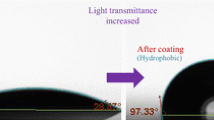Abstract
Self-cleaning glass with a coated external surface exhibits both photocatalytic and photo-induced superhydrophilic properties. Such properties provide the conditions for the decomposition of organic contaminants and washing-off of inorganic ones by rainwater flowing down in the form of a thin film. The basic data on the mechanism of photocatalysis and photo-induced hydrophobicity on titanium dioxide coatings are provided. The data on the optical, structural, photocatalytic, and superhydrophilic properties of the commercial self-cleaning glass are summarized. It is demonstrated that a layer of organic contaminants of a thickness of up to 10 nm can be removed from the glass surface within 1-hour exposure to sunlight/daylight. The absence of standards for self-cleaning glass is underlined; the problems and results of the glass preparation are indicated. An express-analysis method for the photocatalytic activity of self-cleaning articles is described. The results of long-term in situ testing prove the efficiency of these articles.
















Similar content being viewed by others
REFERENCES
Fujishima, A. and Honda, K., Electrochemical photolysis of water at a semiconductor electrode, Nature (London, U.K.), 1972, vol. 238, no. 5358, pp. 37–38.
Fujishima, A., Zhang, X., and Tryk, D.A., TiO2 photocatalysis and related surface phenomena, Surf. Sci. Rep., 2008, vol. 63, pp. 515–582.
Mills, A. and Lee, S.-K., A web-based overview of semiconductor photochemistry-based current commercial applications, J. Photochem. Photobiol., A, 2002, vol. 152, pp. 233–247.
Fujishima, A., Rao, T.N., and Tryk, D.A., Titanium dioxide photocatalysis, J. Photochem. Photobiol., C, 2000, vol. 1, pp. 1–21.
Nakata, K. and Fujishima, A., TiO2 photocatalysis: design and applications, J. Photochem. Photobiol., C, 2012, vol. 13, pp. 169–189.
Carp, O., Huisman, C.L., and Reller, A., Photoinduced reactivity of titanium dioxide, Prog. Solid State Chem., 2004, vol. 32, pp. 33–177.
Banerjee, S., Dionysiou, D.D., and Pillai, S.C., Self-cleaning applications of TiO2 by photo-induced hydrophilicity and photocatalysis, Appl. Catal., B, 2015, vols. 176–177, pp. 396–428.
Wang, R., Hashimoto, K., Fujishima, A., Chikuni, M., Kojima, E., Kitamura, A., Shimohigoshi, M., and Watanabe, T., Light-induced amphiphilic surfaces, Nature (London, U.K.), 1997, vol. 388, no. 6641, pp. 431–432.
Savinov, E.N., Photocatalytic methods of water and air purification, Soros. Obraz. Zh., 2000, vol. 6, no. 11, pp. 52–56.
Watanabe, T., Nakajima, A., Wang, R., Minabe, M., Koizumi, S., Fujishima, A., and Hashimoto, K., Photocatalytic activity and photoinduced hydrophilicity of titanium dioxide coated glass, Thin Solid Films, 1999, vol. 351, pp. 260–263.
Mirror Systems. http://www.murakami-kaimeido.co.jp/english/technology/mirror/index.html.
Fujishima, A. and Zhang, X., Titanium dioxide photocatalysis: present situation and future approaches, C.R. Chim., 2006, vol. 9, pp. 750–760.
Mills, A., Lepre, A., Elliott, N., Bhopal, S., Parkin, I.P., and O’Neill, S.A., Characterisation of the photocatalyst Pilkington Activ™: A reference film photocatalyst?, J. Photochem. Photobiol., A, 2003, vol. 160, pp. 213–224.
Mellott, N.P., Durucan, C., Pantano, C.G., and Guglielmi, M., Commercial and laboratory prepared titanium dioxide thin films for self-cleaning glasses: Photocatalytic performance and chemical durability, Thin Solid Films, 2006, vol. 502, pp. 112–120.
Peruchon, L., Puzenat, E., Girard-Egrot, A., Blum, L., Herrmann, J.M., and Guillard, C., Characterization of self-cleaning glasses using langmuir-blodgett technique to control thickness of stearic acid multilayers: Importance of spectral emission to define standard test, J. Photochem. Photobiol., A, 2008, vol. 197, pp. 170–176.
Midtdal, K. and Jelle, B.P., Self-cleaning glazing products: A state-of-the-art review and future research pathways, Sol. Energy Mater. Sol. Cells, 2013, vol. 109, pp. 126–141.
ISO 27448: 2009. Fine ceramics (advanced ceramics, advanced technical ceramics)—Test method for self-cleaning performance of semiconducting photocatalytic materials—Measurement of water contact angle.
Mills, A., Hill, C., and Robertson, P.K.J., Overview of the current ISO tests for photocatalytic materials, J. Photochem. Photobiol., A, 2012, vol. 237, pp. 7–23.
Mills, A., Hepburn, J., Hazafy, D., O’Rourke, C., Krysa, J., Baudys, M., Zlamal, M., Bartkova, H., Hill, C.E., Winn, K.R., Simonsen, M.E., Søgaard, E.G., Pillai, S.C., Leyland, N.S., Fagan, R., Neumann, F., Lampe, C., and Graumann, T., A simple, inexpensive method for the rapid testing of the photocatalytic activity of self-cleaning surfaces, J. Photochem. Photobiol., A, 2013, vol. 272, pp. 18–20.
Mills, A., Hepburn, J., Hazafy, D., O’Rourke, C., Wells, N., Krysa, J., Baudys, M., Zlamal, M., Bartkova, H., Hill, C.E., Winn, K.R., Simonsen, M.E., Sogaard, E.G., Banerjee, S., Fagan, R., and Pillai, S.C., Photocatalytic activity indicator inks for probing a wide range of surfaces, J. Photochem. Photobiol., A, 2014, vol. 290, pp. 63–71.
Verita, M., Geotti-Bianchini, F., Falcone, R., Zangiacomi, G., Chabas, A., and Lombardo, T., Analysis of self-cleaning and float glass: a comparative study of pollution on the glass surface under real life conditions, Glass Technol., 2007, vol. 48, no. 4, pp. 183–190.
Chabas, A., Gentaz, L., Lombardo, T., Sinegre, R., Falcone, R., Verita, M., and Cachier, H., Wet and dry atmospheric deposition on TiO2 coated glass, Environ. Pollut., 2010, vol. 158, pp. 3507–3512.
GOST (State Standard) No. 111-2014, Sheet colorless glass. Technical conditions, 2015.
www.pilkington.com/en-gb/uk/householders/types-of-glass/self-cleaning-glass.
www.diamond-glass.co.uk/downloads/2013/SGG_ BIOCLEAN.pdf.
www.suburbanconstruction.com/windows-sunclean-glass.html.
www.cardinalcorp.com/products/coated-glass/neat-glass/.
www.wecreatesolutions.com/port/brochures/AMG-Radiance-Brochure.pdf.
http://documents.mx/documents/architectural-glass-specifiers-guide.html.
Author information
Authors and Affiliations
Corresponding author
Ethics declarations
The authors declare that they have no conflict of interest.
Additional information
Translated by D. Marinin
Rights and permissions
About this article
Cite this article
Maiorov, V.A. Self-Cleaning Glass. Glass Phys Chem 45, 161–174 (2019). https://doi.org/10.1134/S1087659619030052
Received:
Revised:
Accepted:
Published:
Issue Date:
DOI: https://doi.org/10.1134/S1087659619030052




